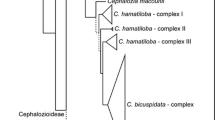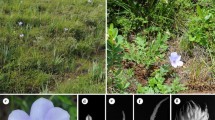Abstract
The inclusion of species of Colchicum within Androcymbium in a previous cpDNA phylogeny of the Colchicaceae, questioned the monophyly of Androcymbium, and it was proposed to unite the two genera in Colchicum. Here we expand the previous phylogenetic analyses of Androcymbium by increasing the taxon sampling and adding more data. The analysis include 29 of the 57 species of Androcymbium, more cpDNA (trnL intron, trnL-trnF IGS, trnY-trnD IGS, and trnH-psbA IGS), and nDNA (RNApol2 intron 23) regions, and morphological and life-history traits data. Both parsimony and Bayesian inference were used. According to our data there is no reason to expand Colchicum to include Androcymbium, but we support the inclusion of Bulbocodium and Merendera within Colchicum. Morphology and life history traits are the main arguments in favor of recognizing Androcymbium as a well-circumscribed genus. In the phylogeny two Androcymbium groups are clearly differentiated: (1) one including species from Western and Eastern South Africa, Namibia, and North Africa, and (2) one including species from the north west of South Africa and south of Namibia.






Similar content being viewed by others
References
Aagesen L, Sanso AM (2003) The phylogeny of the Alstroemeriaceae, based on morphology, rps16 intron, and rbcL sequence data. Syst Bot 28:47–69
APG [Angiosperm Phylogeny Group] (1998) An ordinal classification for the families of flowering plants. Ann Missouri Bot Gard 83:531–553
APG [Angiosperm Phylogeny Group] (2003) An update of the Angiosperm Phylogeny Group classification for the orders and families of flowering plants. Bot J Linn Soc 141:399–436
Baker JG (1874) On the genus Androcymbium, with descriptions of seven new species. J Linn Soc Bot X:243–245
Baker JG (1879) A synopsis of Colchicaceae and the aberrant tribes of Liliaceae. J Linn Soc Lond Bot 17:405–510
Baker RH, Yu X, De Salle R (1998) Assessing the relative contribution of molecular and morphological characters in simultaneous analysis trees. Molec Phylogenet Evol 9:427–436
Barker FK, Lutzoni F (2002) The utility of the incongruence length difference test. Syst Biol 51:625–637
Bayer RJ, Starr JR (1998) Tribal phylogeny of the Asteraceae based on two non-coding chloroplast sequences, the trnL intron and trnL/trnF spacer. Ann Missouri Bot Gard 85:242–256
Bentham G, Hooker JD (1862–1883) Genera plantarum ad exemplaria imprimis in herbariis Kewensibus servata, vol 3. London
Born J, Linder HP, Desmet P (2007) The Greater Cape Floristic Region. J Biogeogr 34:147–162
Bremer B, Jansen RK, Oxelman B, Backlund M, Lantz H, Kim K-J (1999) More characters or more taxa for a robust phylogeny—case study from the coffee family (Rubiaceae). Syst Biol 48:413–435
Bremer K (2000) Early Cretaceous lineages of monocot flowering plants. Proc Natl Acad Sci USA 97:4707–4711
Burtt BL (1968) Colchicum and Merendera. A lily group discussion opened by Mr. B. L. Burtt, with contributions from Mr. R. D. Meikle and Rear-Admiral J. P. W. Furse. Lily Year Book, vol 31, pp 90–105
Caujapé-Castells J, Jansen RK, Pedrola-Monfort J, Membrives N (1999) Chloroplast DNA restriction site phylogeny of the genus Androcymbium (Colchicaceae). Syst Bot 24:581–597
Caujapé-Castells J, Jansen RK, Membrives N, Pedrola-Monfort J, Montserrat JM, Ardanuy A (2001) Historical biogeograpy of Androcymbium Willd. (Colchicaceae) in Africa: evidence from cpDNA RFPLs. Bot J Linn Soc 136:379–392
Colless DH (1980) Congruence between morphometric and allozyme data for Menidia species: a reappraisal. Syst Zool 29:288–299
Colless DH (1981) Predictivity and stability in classifications: some comments on recent studiees. Syst Zool 30:325–331
Dahlgren RMT, Clifford HT, Yeo PF (1985) The families of the monocotyledons: structure, evolution and taxonomy. Springer, Berlin
Darlu P, Lecointre G (2002) When does the incongruence length difference test fail? Molec Biol Evol 19:432–437
Del Hoyo A, Pedrola-Monfort J (2006) Missings links between disjunct populations of Androcymbium (Colchicaceae) in Africa using chloroplast DNA noncoding sequences. In: Columbus JT, Friar EA, Porter JM, Prince LM, Simpson MG (eds) Monocots: comparative biology and evolution, vol I. Rancho Santa Ana Botanic Garden, Claremont, pp 604–616
Denton AL, McConaughy BL, Hall BD (1998) Usefulness of RNA polumerase II coding sequences for estimation of green plant phylogeny. Molec Biol Evol 15:1082–1085
Dolphin K, Belshaw R, Orme DL, Quicke D (2000) Noise and incongruence: interpreting results of the incongruence length difference test. Molec Phylogenet Evol 17:401–406
Doyle JJ (1996) Homoplasy connections and disconnections: genes and species, molecules and morphology. In: Sanderson MJ, Hufford L (eds) Homoplasy: the recurrence of similarity in evolution. Academic Press, San Diego, pp 37–66
Doyle JJ, Doyle JL (1987) A rapid DNA isolation procedure for small quantities of fresh leaf tissue. Phytochem Bull 19:11–15
Farris JS, Källersjö M, Kluge AG, Bult C (1995) Testing significance of incongruence. Cladistics 10:315–319
Felsenstein J (1981) Evolutionary tree from DNA sequences: a maximum likelihood approach. J Molec Evol 17:368–378
Felsenstein J (1985) Confidence limits on phylogenies: an approach using the bootstrap. Evolution 39:783–791
Gielly L, Taberlet P (1994) The use of chloroplast DNA to resolve plant phylogenies: noncoding versus rcbL sequences. Molec Biol Evol 11:769–777
Goldblatt P (1997) Floristic diversity in the Cape Flora of South Africa. Biodiversity Conserv 6:359–377
Goldblatt P, Manning JC (2002) Plant diversity of the cape region of Southern Africa. Ann Missouri Bot Gard 89:281–302
Hahn WJ (2002) A molecular phylogenetic study of the Palmae (Arecaceae) based on atpB, rbcL, and 18S nrDNA sequences. Syst Biol 51:92–112
Hall TA (1999) Bioedit: a user-friendly biological sequence alignment editor and analysis program for windows 95/98/NT. Nucl Acids Symp Ser 41:95–98
Hasegawa M, Kishino H, Yano T (1985) Dating of the huma-ape splitting by a molecular clock of mitochondrial DNA. J Molec Evol 22:160–174
Huelsenbeck JP, Ronquist F (2001) MrBayes: Bayesian inference of phylogenetic trees. Bioinformatics 17:754–755
Krause K (1920) Revision der Gattung Androcymbium Willd. Notizbl Bot Gart Berlin 7:512–526
Li H, Luo J, Kemphill JK, Wang J, Gould JH (2001) A rapid and high yielding DNA miniprep for Cotton (Gossypium spp.). Pl Molec Biol Rep 19:183a–183e
Linder HP (2003) The radiation of the Cape flora, southern Africa. Biol Rev 78:597–638
Linder HP, Hardy CR (2004) Evolution of the species-rich Cape flora. Phil Trans R Soc Lond 359:1623–1632
Maddison DR (2004) Testing monophyly of a group of beetles. Study 1 in Mesquite: a modular system for evolutionary analysis, version 1.04, http://www.mesquiteproject.org
Maddison DR, Maddison WP (2005) MacClade 4: analysis of phylogeny and character evolution, version 4.08, Sinauer, Sunderland, MA, USA
Maddison WP, Maddison DR (2006) Mesquite: a modular system for evolutionary analysis. Version 1.11 http://www.mesquiteproject.org
Manning J, Goldblatt P (2001) Notes on African Plants: Colchicaceae. A remarkable new species of Androcymbium from Northern Cape, South Africa. Bothalia 31:203–205
Manning J, Forest F, Vinnersten A (2007) The genus Colchicum L. redefined to include Androcymbium Willd. based on molecular evidence. Taxon 56(3):872–882
Matheny PB, Liu YJ, Ammirati JF, Hall BD (2002) Using RPB1 sequences to imporve phylogenetic inference among mushrooms (Inocybe, Agaricales). Amer J Bot 89:688–698
Müller-Doblies U, Müller-Doblies D (1984) Zur Kenntnis der Gattung Androcymbium (Colchicaceae) im südlichen Afrika: Zwei Synonyma und fünf neue Arten. Willdenowia 17:179–197
Müller-Doblies U, Müller-Doblies D (1990) Zur Kenntnis der Gattung Androcymbium (Colchicaceae) im südlichen Afrika: 2. Androcymbium exiguum hat doch Artwert. Willdenowia 19:456–470
Müller-Doblies U, Müller-Doblies D (1998) De Liliifloris Notulae 6. De decuria prima specierum novarum generis Androcymbium sect. Androcymbium (Colchicaceae) in Africa Australi s.l. Praeterea novitates de huius sectionis nonnullarum specierum dstributione (praesertim aucta speciminibus STEllenbosensibus i.a. collectis a botanico vero E. G. H. OLIVERO). Feddes Repert 109:551–572
Müller-Doblies U, Müller-Doblies D (2002) De Liliifloris Notulae 7. De decuria altera specierum novarum generis Androcymbium (Colchicaceae) in Africa Australi s.l. Feddes Repert 113:545–599
Nordenstam B (1998) Colchicaceae. In: Kubitzki K (eds) The families and genera of vascular plants III flowering plants, monocotyledons. Springer, Berlin, pp 175–185
O’Donnell K (1992) Ribosomal DNA internal transcribed spacers are highly divergent in the phytopathogenic ascomycete Fusarium sambucinum (Gibberella pulicaris). Cur Genet 22:213–220
Persson K (1992) Liliceae subfam. Wurmbaeoideae Buxbaum. Flora Iranica 170:1–40
Persson K (1993) Reproductive strategies and evolution in Colchicum. In: Proceedings of the 5th optima meetings. Istambul University, Istambul, pp 394–414
Persson K (2007) Nomenclatural synopsis of the genus Colchicum (Colchicaceae), with some new species and combinations. Bot Jahrb Syst 127:165–242
Posada D, Crandall KA (1998) Modeltest: testing the model of DNA substitution. Bioinformatics 14:817–818
Ronquist F, Huelsenbeck JP, Van del Mark P (2005) MrBayes 3.1 Manual. http://mrbayes.csit.fsu.edu/mb3.1_manual.pdf
Sang T, Crawford DJ, Stuessy TF (1997) Chloroplast DNA phylogeny, reticulate evolution, and biogeography of Paeonia (Paeoniaceae). Amer J Bot 84:1120–1136
Schlechtendal DFL (1826) Ueber die Melianthaceen am Vorgebirge der Guten Hoffnung. Linneae 1:78–95
Shaw J, Lickey EB, Beck JT, Farmer SB, Liu W, Miller J, Siripun KC, Winder CT, Schilling EE, Small RL (2005) The tortoise and the hare II: relative utility of 21 noncoding chloroplast DNA sequences for phylogenetic analysis. Amer J Bot 92:142–166
Simmons MP, Ochoterena H (2000) Gaps as characters in sequence-based phylogenetic analyses. Syst Biol 49(2):369–381
Stefanov B (1926) Monografiya na roda Colchicum L. Sborn Balg Nauk Sofiya 22:1–100
Swofford DL (2003) Phylogenetic analysis using parsimony, PAUP*, 4.0b10. Sinauer., Sunderland, MA, USA
Tate JA, Simpson BB (2003) Paraphyly of Tarasa (Malvaceae) and diverse origins of the polyploid species. Syst Bot 28:723–737
Thompson JD, Higgins DG, Gibon TJ (1994) CLUSTAL W: improving the sensitivity of progressive multiple sequence alignment through sequence weighting, position-specific gap penalties and weight matrix choice. Nucl Acids Res 22:4673–4680
van Ham RCHJ, T’Hart H., Mes THM, Sandbrink JM (1994) Molecular evolution of noncoding regions of the chloroplast genome in the Crassulaceae and related species. Cur Genet 25:558–566
Vinnersten A, Bremer K (2001) Age and biogeography of major clades in Liliales. Amer J Bot 88:1695–1703
Vinnersten A, Reeves G (2003) Phylogenetic relationships within Colchicaceae. Amer J Bot 90:1455–1462
Vogel S (1954) Blütenbiologische Typen als Elemente der Sippengliederung. Jena
Wiens JJ (1998) Combining data sets with different phylogenetic histories. Syst Biol 47:568–581
Willdenow F (1808) Nähere Bestimmung einiger Liliengewächse besonders aber derjenigen, die zur sechsten Klasse und dritten Ordnung des Linnéschen Systems gehören. Ges Naturforsch Freunde Berlin Magazin 2:14–30
Wortley AH, Scotland RW (2006) The effect of combining molecular and morphological data in published phylogenetic analyses. Syst Biol 55:677–685
Yoder AD, Irwin JA, Payseur BA (2001) Failure of the ILD to determine data combinability for slow loris phylogeny. Syst Biol 50:408–424
Young ND, Healy J (2003) Gapcoder automates the use of indel characters in phylogenetic analysis. BMC Bioinfor 4:6
Acknowledgments
The authors thank the Genetic area of the Department of Biology of the University of Girona, specially J. L. García-Marín, for his help with the sequencing of the samples, G. Petersen and O. Seberg, from the Laboratory for Molecular Systematics of the Copenhagen University, for their help with the final revision of this manuscript, and we are specially indebt with K. Persson, from the Botanical Institute of the Göteborg University, for her comments and suggestions. The authors are indebted to with the Carl Faust Foundation, which provided all the plant material, the maintenance of living collections of Androcymbium, and founded this research.
Author information
Authors and Affiliations
Corresponding author
Rights and permissions
About this article
Cite this article
del Hoyo, A., Pedrola-Monfort, J. Phylogeny of Androcymbium (Colchicaceae) based on morphology and DNA sequences. Plant Syst Evol 273, 151–167 (2008). https://doi.org/10.1007/s00606-008-0007-1
Received:
Accepted:
Published:
Issue Date:
DOI: https://doi.org/10.1007/s00606-008-0007-1




